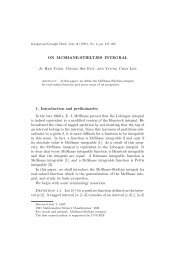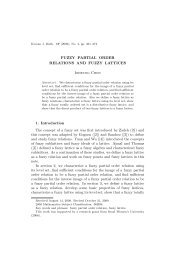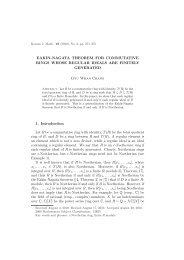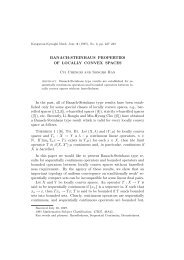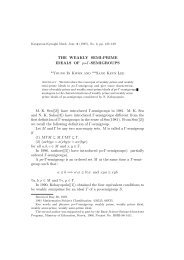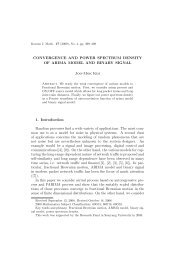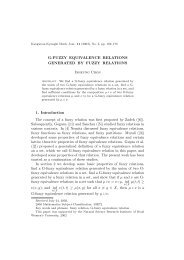ϵ-FUZZY EQUIVALENCE RELATIONS Inheung Chon 1 ...
ϵ-FUZZY EQUIVALENCE RELATIONS Inheung Chon 1 ...
ϵ-FUZZY EQUIVALENCE RELATIONS Inheung Chon 1 ...
Create successful ePaper yourself
Turn your PDF publications into a flip-book with our unique Google optimized e-Paper software.
76 <strong>Inheung</strong> <strong>Chon</strong>set X. For 0 < p ≤ ɛ, a relation ≺ p on X is defined by x ≺ p y iffµ(x, y) ≥ p.Proposition 4.2. Let µ be an ɛ-fuzzy equivalence relation on aset X. Then the relation ≺ p on a set X defined in Definition 4.1 is anequivalence relation.Proof. Since µ(x, x) ≥ ɛ ≥ p, ≺ p is reflexive. Suppose x ≺ p y.Then µ(x, y) ≥ p, and hence µ(y, x) ≥ p. Thus ≺ p is symmetric. Supposex ≺ p y and y ≺ p z. Then µ(x, y) ≥ p and µ(y, z) ≥ p. µ(x, z) =(µ ◦ µ)(x, z) = sup min(µ(x, k), µ(k, z)) ≥k∈Xmin(µ(x, y), µ(y, z)) ≥ p. Thus ≺ p is transitive.□Definition 4.3. Let µ be an ɛ-fuzzy equivalence relation on a setX and let ≺ p be an equivalence relation on X defined in Proposition4.2. The equivalence class containing x is denoted by [x] p . That is,[x] p = {y ∈ X : y ≺ p x} for p ≤ ɛ.Definition 4.4. Let µ be an ɛ-fuzzy equivalence relation on a setX and let ≺ p be an equivalence relation on X defined in Proposition4.2. A fuzzy subset µ [x]ɛ on a set X is defined by µ [x]ɛ (y) = µ(x, y).Definition 4.5. Let {ν i : ∈ I} be a collection of fuzzy sets on aset X. If (∪ i∈I ν i )(z) ≥ p and ν i ∩ ν j = 0 for all i, j ∈ I with i ≠ j,we call {ν i : i ∈ I} is a fuzzy partition of a fuzzy set χ p Xon X, whereχ p X : X → R is a function defined by χp X(x) ≥ p for all x ∈ X.Lemma 4.6. Let µ be an ɛ-fuzzy equivalence relation on a set X.Then [x] p ∩ [y] p = ∅ for some 0 < p ≤ ɛ iff (µ [x]ɛ ∩ µ [y]ɛ )(z) = 0 for allz ∈ X.Proof. (→) Suppose (µ [x]ɛ ∩ µ [y]ɛ )(z) > 0 for some z ∈ X. Thenµ [x]ɛ (z) ≥ p and µ [y]ɛ (z) ≥ p for some p ≤ ɛ. That is, µ(x, z) ≥ p andµ(y, z) ≥ p. Thus µ(x, y) ≥ (µ◦µ)(x, y) = sup min(µ(x, k), µ(k, y)) ≥k∈Xmin(µ(x, z), µ(y, z)) ≥ p. That is, x ≺ p y. This contradicts [x] p ∩[y] p =∅.(→) Suppose α ∈ [x] p ∩ [y] p . Then x ≺ p α and y ≺ p α. Since ≺ p isan equivalence relation by Proposition 4.2, x ≺ p y. Thus µ(x, y) ≥ p.Since µ(y, y) ≥ ɛ and p ≤ ɛ, (µ [x]ɛ ∩ µ [y]ɛ )(y) = min(µ(x, y), µ(y, y)) ≥p. This contradicts that (µ [x]ɛ ∩ µ [y]ɛ )(z) = 0 for all z ∈ X. □



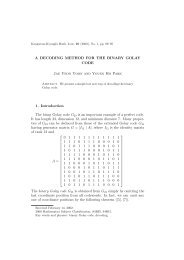
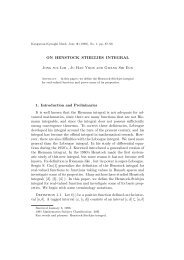
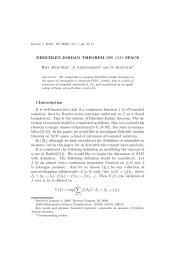

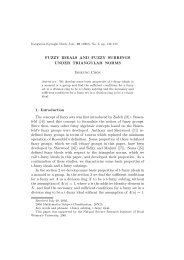
![SEMI-REGULAR po-SEMIGROUPS SK Lee J. Calais([1])](https://img.yumpu.com/46211509/1/184x260/semi-regular-po-semigroups-sk-lee-j-calais1.jpg?quality=85)
